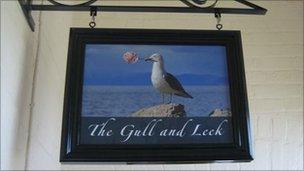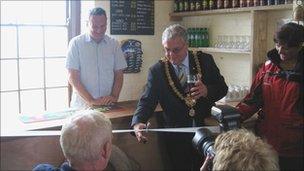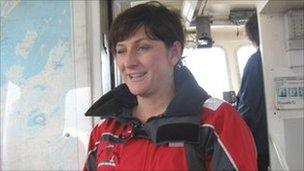Gull and Leek pub opens on Flat Holm island
- Published

The Gull and Leek is situated on Flat Holm island, a nature reserve a few miles from Cardiff Bay
The Gull and Leek, one of the most unusual pubs in Wales, has opened. But, as Andy Gourlay found, a visit requires some planning, because it is on the nature reserve island of Flat Holm.
On the face of it, it's not the most promising site for a new pub.
In the middle of nowhere, you can't park and the locals are a noisy bunch intent on pinching your sandwiches.
But despite all that, the Gull and Leek, the new pub on the nature reserve at Flat Holm island is sure to be a hit with visitors who do manage to drop in.
Unless you happen to own a boat, there's no nipping over for a quick pint as a trip there takes a bit of forward planning.
It starts at Cardiff Bay where you board the Lewis Alexander, the Flat Holm Project's custom-made boat for the 50-minute journey, which also takes you through the giant sea lock at the Cardiff Bay barrage.
There is no quay on the island and the boat has no option but to land by simply driving headlong up a ramp on the beach. It's got a specially designed reinforced hull, which is just as well.
Flat Holm lies a few miles off the south Wales coastline between Barry and Penarth, and is the most southern tip of Wales - neighbouring Steep Holm is just over the border in England.

The gulls on Flat Holm may have to get used to an influx of thirsty new visitors
Our guide for the pub's grand opening is Flat Holm manager Natalie Taylor. But before we hit the bar, she gives us a tour of the island, starting with a rundown on Flat Holm's long and varied history.
Bronze Age relics have been found here but the earliest known visitor was St Cadoc in the 6th Century, who came to the island to meditate.
He is said to have survived on a diet of water and wild leeks, which thrive on the island and, along with the gulls, give the pub its name.
Vikings and Saxons, monks and silver miners have all occupied Flat Holm at some point, while brandy and tea smugglers used its rocky coves to store contraband.
Victorian gun
These days what you can see now are remnants of the diverse ways the island has been used over recent centuries.
We pass a ruined hospital, used as an isolation unit for victims of cholera and bubonic plague.
The Victorian gun emplacements, installed to ward off the French, and the World War II anti-aircraft batteries are still visible, complete with a huge Victorian gun lying nearby.
Sadly there's no sign of the exact spot where Marconi famously used the island to send the first wireless message across the water.

Cardiff lord mayor Delme Bowen performs the opening duties at The Gull and Leek
"Are you ready?" was excitedly decoded in Lavernock Point. I wonder if Marconi meant those actual words to go down in history or if he was planning to say something more profound.
All the same, there's a little monument to the achievement, in the gull colony.
Other buildings still intact are being renovated by volunteers from the Flat Holm Society.
The old farmhouse has been turned into an accommodation block and the fog horn master's cabin is being converted to a self-contained cottage.
Potential renters will be comforted to learn the enormous horn has long been decommissioned.
Dive bombing
The lighthouse, built in 1820, is still working, but these days it is solar powered.

Flat Holm manager Natalie Taylor says the cost of developing the bar is very little
I'm working up a thirst now and start eyeing the old barracks which houses the museum, shop and, most importantly, the new pub.
But Natalie insists we must first visit the gull colony. That's gulls, not seagulls, we're told: lesser black-backed gulls to be precise. There are 2,000 breeding pairs on the island and they all seem to be home today.
The noise is incredible and we soon beat a hasty retreat from the dive bombing to the sanctuary of the pub.
The first pint here in 90 years is poured and we all toast the pub's success.
Yes, it's a long way to go for a drink, but Wales' most southerly pub is well worth the trip.
- Published23 June 2011
- Published9 August 2010